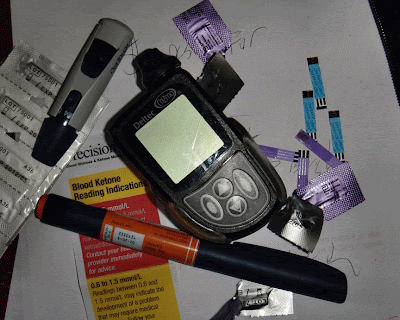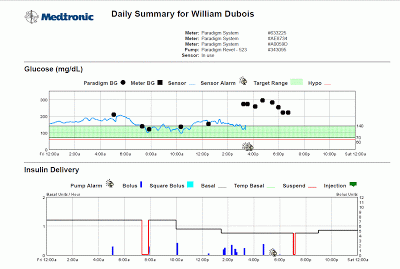Further proof that God has an excellent sense of humor
My mouth watering, I entered the 35 carbs for the taco salad into the Bolus Wizard, clipped the pump back on my belt, and picked up my fork.
The pump vibrated on my hip. Then vibrated again. And then kept on vibrating.
Uh-oh.
I reached for the pump. Motor Error.
And then… and then…
And then I laughed out loud. I showed the pump to Debbie and she collapsed in a fit of giggles. Rio, not the type to be left out (but not sure what was so funny about a Motor Error) starting laughing, too.
What was so funny was the fact that, just hours before, two Medtronic engineers had gotten back on a plane for California following a 2-day visit to my home, recreation, and work locations. Their mission: to find a smoking gun. Or at least rule out a few theories.
I had joked with them that fucking Pump the Fifth would probably fail as soon as they got back on the damn plane, but I didn’t really believe it would happen. But, basically, that’s exactly what did happen. This latest Motor Error didn’t even upset me. It was just too fucking ironic to do anything other than laugh.
I let my Taco salad cool and went into my library to do the trace upload, only seconds from the event. In fact, the pump was still in its alarm state and wouldn’t upload. I cancelled the alarm, then I did the all-to-familiar ritual:
I removed the reservoir from the pump—calling it a fucking piece of shit, just for fun this time, and to keep the tradition alive—and rewound the pump. Then I re-inserted the reservoir. Locked it into place. Pressed ACT. Confirmed I was disconnected by arrowing down to “Yes” and pressing ACT again. Then I held the ACT button down to move the plunger forward, the pump chirping the whole time. Once I saw a drop of crystal clear Novolog at the tip of the tube’s quick disconnect, I told the pump, that yes, I see drops by arrowing down to “Yes” and pressing ACT. I then had to press ESC to bypass filling the cannula, and then twice more to get the home screen, and then I uploaded the pump, emailed a few people at Medtronic, just to ruin their evenings, and went back to my taco salad.
But, you know what, dearest reader? I owe you an apology. This story is out of order. We really need to go back in time. Back to when I was recently asked to donate my body to science… before I died. Oh, yes. And I also need to tell you the story of the suicide vest.
It all started with a phone call…
BaaaRingg!...ning…ning…
BaaaRingg!...ning…ning… said my antique brass-belled phone.
Medtronic was calling. They wanted to send a couple of the engineers who were working on my mystery Motor Errors out to New Mexico to meet me in person, run some tests, and generally get the lay of the land at the scene of the crime. Would I mind?
Not at all.
Oh and one more thing. Would I mind wearing Revel again, just while they are there?
Uhhhh…..
I hesitated a long time. I wasn’t really too keen on putting the little fucker back on. But, well, in the interest of science… and what’s the worst that could happen? I mean, other than ketones, DKA, and death? I decided I’d be hyper alert, just wear it as long as they were here, then go back to the CoZmo. I consented.
About a week later the Ghostbusters themselves were sitting at my kitchen table. Well two of them anyway. I think there were actually four Ghostbusters in the original movie. Medtronic only sent Dan Aykroyd and Harold Ramis:
But they came complete with Ghostbuster-like air sniffers to search for phantom magnetic fields.
With no luck.
Still, with Dan and Harold looking on, I booted up Pump the Fifth again. I brought the program back to life. Filled a reservoir with Novolog. Attached an infusion set. Did the whole rewind thing and then I stopped. I was probably only for a few seconds. But it seemed like hours to me.
In the dark recesses of my mind I was thinking: So this is what it feels like to strap on a suicide vest.
Well. OK. I exaggerate. But it felt strange to attach a piece of gear to my body that’s tried to kill me so many times. But this was in the interest of science. I pressed the blue inserter device against my stomach and pulled the trigger.
Thump!
Then nothing happened. Of course. Anyway “Dan” and “Harold” spent the afternoon at my house asking questions about the failures, how I use the pump, and what the price of tea in China was. It wasn’t good-cop/bad-cop. It was good-cop/good-cop and our conversation ranged over the full range of insulin pump topics with them frequently telling me that they couldn’t answer the various questions I was putting to them (mainly about new developments and next gen pumps, which I knew they couldn’t answer, but I had to try anyway).
Then we grabbed dinner in town. The next day they came to the clinic and did the Ghostbuster thing there, too. Despite what some of the nurses say about the clinic maybe being built on an old Indian burial ground, no evidence was found for the kind of ghosts that would haunt five insulin pumps.
My visitors didn’t learn much, but I learned that No Delivery alarms are mechanical in nature and Motor Errors are software driven. I was also intrigued to learn that while the pump’s black box will normally show precursor events leading up to a fatal crash, my Motor Errors literally appear out of the blue.
The Ghostbusters tell me they’ve never seen that before.
Ever.
Grrrrrrrrrrrreat.
So no smoking guns found, and at least two hopeful theories ruled out (the magnetic one and the un-mentioned one that I don’t know what the fuck I’m doing when I put a set on) they left again.
Oh, and to add irony to irony, I need to tell you about the conversation at the kitchen table moments before the final Motor Error.
The Revel was back on and behaving. It had a fresh reservoir of insulin. I was wearing a Med-T sensor. Do I take it back off, and if so, when? Or should I give it another chance?
Moments later, the pump made the choice for me.
After I finished my taco salad, I pulled the plug on it. The next morning the re-neutered Revel, now on Guardian duty, “lost” the Med-T sensor and stopped working. Screw this, I decided. I pulled out the sensor and put a Dexcom on my arm.
Now we’re going to see just how much we’ve come to depend on mySentry. I shut off the switch to the power strip that fed the Outpost. It winked out. Then I pulled the plug on the mySentry monitor.
A few minutes later, Sentry started emitting pitiful little chirps. It was the lost power alarm, a safety feature for sleeping parents to alert them to a nocturnal loss of alarm coverage.
It sounded like Sentry was begging me to turn him back on again.
I hesitated, then I pulled the power cord out of the back of the monitor—and it fell silent.





























